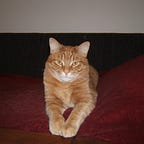Do Bananas Exist?
A Deep Dive Into Cryptobotany
Bananas.
Do they?
Are they?
Were they?
Would they?
Well no.
At least, that’s what Big Science WANTS you to think.
Nevertheless, debate about the existence of bananas still rages.
A few remarkable photographs, purporting to show actual bananas, seem to bely those Big Science claims.
The most convincing of these is the “Lexington Photo”, a grainy image of a flattened banana at the intersection of Portage and Maine in Winnipeg, Canada, which was discovered when the image on an 8-cent stamp from 1974 was blown up.
More recently, the erstwhile “Gogglebro” photo of a banana protruding from the mouth of a white-tailed deer head in a bar in Saskatoon was debunked when the photographer confessed on his deathbed. “I got drunk, painted a cigar, and stuck it in a deer. Sue me. But I didn’t put the goggles on the deer. That was somebody else.”
Another famous hoax occurred at the Royal Albert Hall and resulted in a stampede. The offending item was later discovered to be made of rubber, but it is now illegal to scream the word “Banana!” in public in England.
But what about evidence from the era before photography? We see bananas there. Throughout history, artists have depicted numerous supposedly mythological phenomena: angels, demons, dragons, bananas.
“What you have to understand,” says art historian Harriet Wainscotting, “is that those old-timey artists did a lot of opium. So it’s a really bad idea to take any of their work seriously. I mean, one artist’s cat pukes into a fruit bowl, the artist has opium for breakfast — bing-bang-boom — that puke becomes a banana. Which is why it’s so dangerous to let botanists loose in art galleries. The next thing you know, they’re applying taxonomic classifications to Gauguin’s nose goblins, just because he had a magic mushroom sandwich that day.”
Whether bananas are narcotically-induced hallucinations or not, artists seem to have established amongst themselves the “look” of a banana that has subsequently become fancanon.
According to banana fancanon, bananas are yellow (occasionally with black markings), although they may be green or, less commonly, orange. They are slightly curved with a fibrous stem. They travel in packs, are crepuscular, and prey on small mammals. Their natural predator is the aardwolf. They emit sounds inaudible to the human ear, but which may cause penguins to aggregate. Regarding the sexual orientation of bananas, fans are split. Some believe they are pansexual.
“I wouldn’t say I’d ship one with a watermelon,” says one fanfic author, “but I wouldn’t say I’d not ship one with a watermelon. It would have to be the right situation. With the right watermelon.”
Nevertheless, most people have bought into the Big Science worldview of the non-existence of bananas.
Says Betty Whip, 56, a self-described “banana atheist” from Chutney: “I think bananas are codswallop and anyone who believes in them should be sectioned.”
“I used to believe in them when I was a young child,” says John Merther, 76, of Paisley (who wishes to remain anonymous), “but when I turned 10, after an incident at school, I started to question their existence. Now that I’m an adult, I realize that bananas are a myth that parents tell children to get them to behave. I think it’s child abuse, really, and something should be done about it.”
Despite a lack of evidence in the peer-reviewed scientific literature supporting the existence of bananas, a belief in bananas persists in certain pockets of the population.
We interviewed several people who claim to have seen a banana.
“I was shopping at Canadian Tire and there it was in the Lawn Ornaments aisle, sitting inside a giant plaster swan. I went to get my wife, but by the time we got back, it had gone. The swan was still there, though.”
Not convinced? Read on.
“A cousin of mine used to bring them over from India,” says James Fropple, 45, of Winston. “They have lots of them there.”
However, when we asked him to show us one of these so-called bananas, James claimed that he and his cousin “ate them all”.
Apparently, James isn’t the only person who believes that bananas are edible.
“Of course bananas exist,” says Martha Streetview of Avenue Road, “I bake them in bread all the time. Sheesh.”
We tried some of Martha’s “banana bread”. It tasted revolting. Also, when we cut it open, nothing inside it resembled a fancanon banana.
When we brought Martha’s bread to the head honchos at Big Science, we were laughed out of the laboratory. Also, they confiscated Martha’s bread. When we asked Frederick Logic, CEO of Big Science for comment, he said, “Wheeeeeee!!!!!” and went back to do doing donuts in the parking lot on his unicycle.
Perhaps the definitive word can only come from the brave, the bold, the professional botanists.
“I think that a lot of the people who claim to have seen a banana have actually seen a plantain,” says Idaho Brown (botanist). “They do look similar. The way you tell them apart is, plantains are elongated greenish-yellow fruit covered by an inedible peel, whereas bananas do not exist. The best advice I can give to anyone who thinks they’ve seen an actual banana, is to call 911.”
